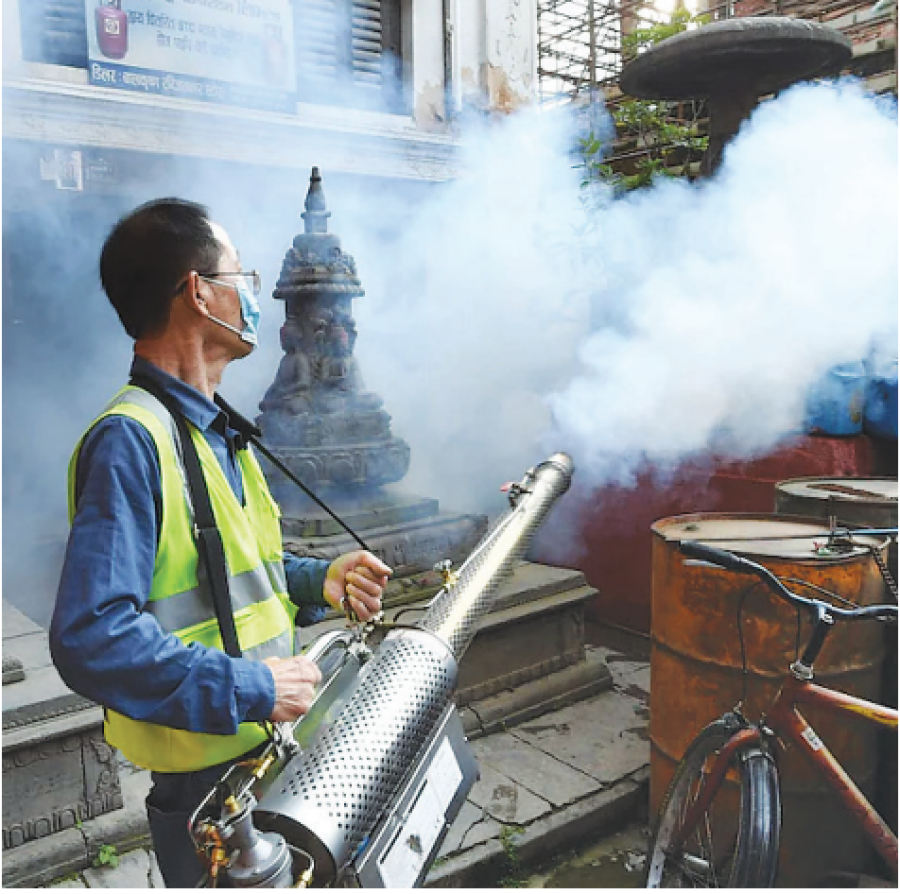Health
As dengue spread across country, authorities sat on their hands
Little was done to contain the virus. Proper risk communication found lacking.
Arjun Poudel
Over 150 dengue patients visit the Sukraraj Tropical and Infectious Disease Hospital every day. Around half of them are serious and need either emergency care or hospitalisation, according to doctors at the hospital.
“Although the dengue cases in the Kathmandu Valley are on a decline, we are still seeing dozens of serious cases every single day,” said Nabaraj Gautam, information officer at the hospital.
According to the Ministry of Health and Population, 47 people have died and over 38,000 have been infected with the dengue virus this year—a record for a single year.
Those closely tracking the cases suspect many more people could have succumbed to the disease as not all deaths are reported.
Officials at the Health Ministry concede that hundreds of thousands of people might have caught the virus. Many infected people do not seek care and up to 90 percent are asymptomatic.
“I went to Civil Hospital yesterday to meet a relative who was admitted there due to dengue-related complications,” said a Health Ministry official, asking not to be named. “All emergency beds of the hospital were occupied by dengue patients. Some beds had two or three patients.”
Despite the deaths of dozens of people and thousands getting infected, no proper measures have been taken to contain the spread of the virus. Agencies concerned do not even update dengue-related data on official holidays.
The Epidemiology and Disease Control Division recommended that the Health Ministry declare a dengue epidemic in the country, but ministry officials refused, arguing infections would naturally decline with a dip in temperatures.
“We hoped for a decline in the number of cases within a few weeks of the first dengue outbreak and did not think it necessary to declare an epidemic or to take containment measures,” the official added. “But neither the spread nor rainfall declined. Had we taken containment measures and sensitised the public on time, things would definitely have been better.”
The division had also recommended spraying insecticides and search and destroy drives, among other measures, to contain the contagion. But except for counting the number of deceased and infected people, nothing substantial was done, public health experts said. This led to an unchecked spread of the disease across the country.
Though the federal government asked local units to carry out fogging in their areas, there was no monitoring to check for local units’ compliance with the directive. Dengue virus is killed with measures including fogging; the spraying needs to continue until the risk goes away.
But many local units had expressed their inability to carry out mosquito search and destroy drives citing a lack of funds for the task.
Female Aedes aegypti and Aedes albopictus mosquitoes transmit the dengue virus. The vectors also transmit chikungunya, yellow fever, and Zika viruses, according to the World Health Organisation.
Experts said lack of hospital beds for serious patients, scarcity of paracetamol in pharmacies and shortage of blood in distribution centres further worsened the crisis. Testing for dengue is costly too. So most people reached the hospital only after getting seriously ill.
“We don’t know how many people have to die for the authorities to declare an epidemic and take containment measures,” said Dr Prabhat Adhikari, an infectious disease and critical care expert. “Every household in the Valley has been affected by dengue but the authorities still seem unbothered.”
Political parties, international organisations, and professional bodies have also been blamed for failing to raise the issue of dengue spread seriously.
“If dengue were as fatal as Covid-19, many more people would die from this kind of government negligence,” Adhikari said. “But that dengue virus does not kill as many should have been no cause for complacency.”
The authorities did not even consider it necessary to make the public aware of the risks of this disease.
Experts said celebrities and public figures could have been used to better inform the public, as similar measures have worked in other instances in the past. Yet this too was considered unnecessary.
The World Health Organisation said that risk communication includes real-time exchange of information, advice, and opinions between experts or officials and people who face the threat to their survival, health, or economic and social well-being. Through such communication, everyone at risk is able to make informed decisions to mitigate the effects of the threat and take protective and preventive measures, says the UN health agency.
“Behavioural change plays a vital role in containing the spread of dengue virus,” said Dr Radhika Thapaliya, a risk communication expert. “Had we communicated the associated risk properly, we could have cut the infection rate.”
Officials at the Health Ministry, however, refuse to take all the blame, while questioning the roles of local and provincial governments and other responsible actors.
“We cannot completely rely on the Health Ministry to solve all dengue-related problems,” said Dr Samir Kumar Adhikari, joint spokesperson for the Health Ministry. “All concerned agencies should fulfil their roles in order to contain the spread of the disease.”




 7.12°C Kathmandu
7.12°C Kathmandu













%20(1).jpg&w=300&height=200)
